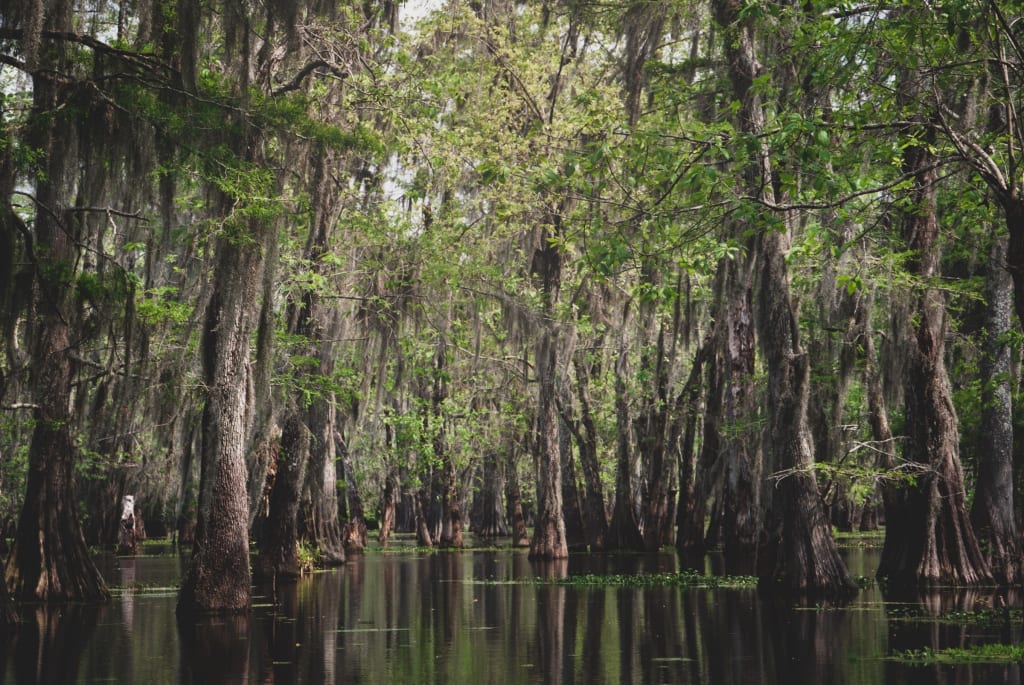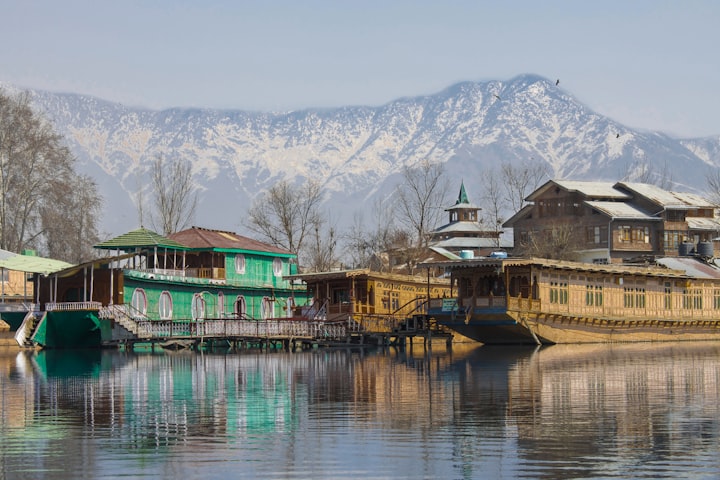Louisiana’s First Climate Change Refugees
The isle’s tribes fled here after escaping the Trail of Tears and Indian Removal Act. Now they’re fleeing climate change.

The residents of Isle de Jean Charles in Louisiana’s southeastern bayous are the first trickle in the coming wave of climate change refugees. For decades, the tribes (Biloxi-Chitimacha-Choctaw and United Houma Nations) who once called the isle home have been relocating to safer land. 98 percent of the isle’s land has sunk under the rising tide since 1955, with nothing but a thin strip of land left.
The isle’s tribes fled here after escaping the Trail of Tears and Indian Removal Act. The isolated bayou island was a safe place where the tribes could raise a family and escape persecution. It was not an easy life but these settlers made due, mainly through fishing and subsistence farming. By 1910, 77 families called the Isle de Jean Charles home. A road connecting the isle to land was finally built in 1953, but before this, everyone used boat travel to get to and from the mainland. While their ancestors came here to escape the world, the world was thrust onto them in the 1940s, when oil drilling and dredging projects arrived in nearby waters, which further eroded the isle. At the time, it was 11 miles long and 5 miles wide — today it is only 2 miles long by a ¼ mile wide.
One huge culprit for the disappearing coastline is the oil and gas industry. These organizations came into Louisiana in full force in the early part of the twentieth century. They dug deep wells, installed long pipelines, and crafted canals to transport equipment and machinery through the swamps. These scars in the marshland are situated all along the coast and hastened the rate at which ocean water could penetrate the marshes. The U.S. Department of the Interior estimates that the oil and gas industry’s work in Louisiana is responsible for somewhere between 15 and 59 percent of the coastline’s decline; researchers working for oil and gas industries place the blame at about 36 percent. R. Eugene Turner, a wetlands expert at Louisiana State University, places about 90 percent of the blame on the industry.
“It’s as if your $25,000 car were hit by a truck, and the driver offered you $10 to call it even,” explained John Barry in an NRDC article by Brian Palmer. “As ridiculous as it sounds, that’s the approximate ratio of what they’ve paid to their actual liability.”
John Barry is an acclaimed author turned environmental advocate. In 2013, he helped launch a lawsuit against oil companies to make them financially liable for their damage to the coast.
“There are few cases of this type in American history, where an environmental injury produced such significant human risk. There’s nothing out there like this — not in the extent of the damage of the extent of the compensation claimed,” explained Oliver Houck, a Tulane University law professor specializing in environmental law, in a 2014 interview with the New York Times in The Most Ambitious Environmental Lawsuit Ever by Nathaniel Rich.
The lawsuit was highly controversial in local government, which Barry says is because many have received large donations from the oil and gas industries.
“Ever since that lawsuit was filed, the industry has said the suit threatened industry’s cooperation with those trying to preserve the coast. What cooperation? Well, Chevron, which (through Texaco, which it now owns) probably caused more damage than anyone else, brags about supporting a project that will create 293 acres in South Lafourche. But there are 640 acres in a square mile, and the state has lost nearly 2,000 square miles,” Barry writes on his website.
Officials all over the country are closely watching the current relocation efforts in rural Alaska and coastal Louisiana. As climate change accelerates, these communities will be a model of relocation for small, rural settlements.
“What comes out of the Isle De Jean Charles relocation effort may well inform what the federal government thinks it can do,” said Mark Davis, director of the Tulane Institute on Water Resources Law and Policy in a Quartz article by Neha Thirani Bagri. “I mean, heavens, if you can’t move 50 people, how do you move 100,000? And if you do successfully move 50, what does that tell you might be possible elsewhere?”
A March 2016 study gave a chilling prediction of the widespread damage that the next generation will face. Researchers calculated that there would be a 6 foot rise in sea levels by the year 2100. In the event of this rise, 13 million Americans would lose their homes. Even just a rise of three feet would destroy the homes of four million Americans. More conservative estimates predict a rise between 1.5 to 3 feet by 2100 if emission targets are not achieved globally.
Even today, Louisiana loses land the size of a football field to the sea every hour, a fact repeated often in newspapers and magazines. For coastal Louisiana residents, climate change and rising sea levels aren’t a futuristic thought experiment — the effects of climate change are being felt now as the sea swallows neighborhoods, and entire communities are facing incredibly costly relocation projects.
“In Florida, one in eight homes — worth over $400 billion in current housing value — could be underwater by 2100,” wrote Neha Thirani Bagri in The US is relocating an entire town because of climate change. And this is just the beginning.
Not only are rising sea levels an increasingly urgent problem for low-lying coastal areas, but researchers suggest that hurricanes will be stronger as climate change accelerates. Louisiana’s coastal wetlands are in the most imminent danger of disappearing, which unfortunately makes the state’s hurricane vulnerability greater. The wetlands act as a natural buffer against hurricanes, slowing them down before hitting heavily populated cities like New Orleans.
According to a United Nations study from 2017, 37 percent of the world’s population lives in coastal communities and around 40 percent live within 60 miles of the coast. With rising sea levels, increasing extreme weather events, and ecosystem destruction, coastal environments are facing severe vulnerability. This can be seen on a micro level in Louisiana, due in part to their very low elevation, making even a small rise in the sea level damaging for some of their communities.
Caribbean islands are even more vulnerable, facing many of the same issues as Louisiana’s coast, but without the possibility of extensive government support or the high GDP needed to rebuild or relocate. In the case of the Isle de Jean Charles, the community received a grant to move. Relocation would have been financially impossible for many residents without government aid.
“The passage of Hurricane Ivan in 2004 over Grenada caused more than US$900 million in destruction which was twice the island’s GDP. 80% of the country’s building structures were damaged or destroyed and in June 2005, the country’s public debt stood at US$560 million or 130% of GDP. The hurricane affected 27,000 homes (89% of the housing stock), 73 of the 75 public schools, and 69% of the infrastructure in the health sector. It took more than 5 years for the island to physically recover (World Bank 2005),” said one report titled Impacts of Climate Change on Settlements and Infrastructure in the Coastal and Marine Environments of Caribbean Small Island Developing States (SIDS) by Adrian Cashman and Mohammad R. Nagdee.
Even for islands with high elevations, a significant portion of the population and capital investments are in vulnerable areas on the shore. Take Jamaica, for instance, in which over half of the island’s economic assets and infrastructure are in vulnerable coastal areas.
Louisiana has undertaken some lofty coastal restoration initiatives, including the $50 billion Master Plan for a Sustainable Coast. This plan hopes to re-engineer Louisiana’s coastal infrastructure to brace the state against the effects of climate change. Additionally, the governor also committed to lowering the state’s greenhouse gas emissions through the newly minted Climate Change Task Force. These widely supported measures are a step in the right direction but there is still a long way to go.
Louisiana’s coastal tribal communities endure the social, health, and economic impacts of climate change, as the land they called home for centuries slips under the rising tides.
While indigenous people flee from their disappearing ancestral safe haven, the oil drills only a few miles away can continue without even a slightly proportional word of blame to fall on their ears.
About the Creator
Raisa Nastukova
Freelance journalist focused on stories of both Kashmir culture and society as well as the rising tide of climate change.






Comments
There are no comments for this story
Be the first to respond and start the conversation.